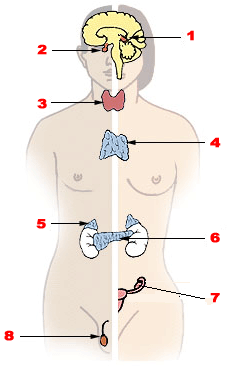Endocrine system
 From Wikiversity - Reading time: 2 min
From Wikiversity - Reading time: 2 min
The endocrine system is a control system that mediates many processes within the body. This is brought about by the secretion of chemical messengers by the endocrine organs. These chemical messengers are known as hormones.
Types of hormone
[edit | edit source]Hormones are small molecules secreted into the blood by the endocrine organs. They can be broadly grouped into three categories:
- Tyrosine derived hormones, such as the catecholamines and thyroid hormones.
- Lipid hormones, which can be divided into two main subgroups; steroid hormones and eicosanoid hormones. Testosterone and cortisol are steroid hormones. Prostaglandins are examples of eicosanoid hormones.
- Protein and peptide hormones, composed of a single chain of amino acids. Examples of small peptide hormones are thyrotropin-releasing hormone (TRH) and vasopressin. Insulin and growth hormone (GH) are protein hormones.
Types of signalling
[edit | edit source]The typical mode of cell signaling in the endocrine system is endocrine signaling. However, there are also other modes, which are important in the body; paracrine and autocrine.

Endocrine signalling
[edit | edit source]Endocrine signals have their target organs or cells at a distant location in the body. Examples of endocrine glands are the pituitary, thyroid, and adrenal glands. Typical features of endocrine glands are their ductless nature, their vascularity and the presence of intracellular vacuoles or granules storing their hormones.
Paracrine signalling
[edit | edit source]Paracrine signals target nearby cells. Examples are nitric oxide and chemicals which promote inflammation.
Autocrine signalling
[edit | edit source]Autocrine signals act on the secreting cell.

The endocrine organs
[edit | edit source]The major endocrine glands are the pituitary (anterior and posterior lobes), thyroid, parathyroid, adrenal (cortex and medulla), pancreas and gonads. They play important roles in many homeostatic mechanisms, often working together in sequence. A number of glands that signal each other in sequence are usually referred to as an axis, for example, the Hypothalamic-pituitary-adrenal axis. There are also a number of other organs that secrete hormones. The heart, for example, secretes atrial-natriuretic peptide (ANP) which is involved in the regulation of blood pressure. it can metabolize
 KSF
KSF